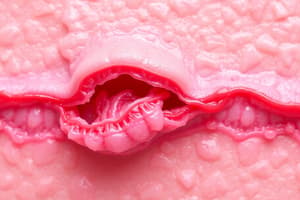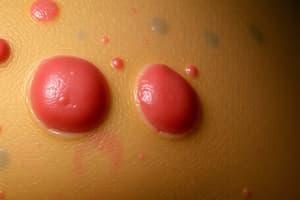Podcast
Questions and Answers
What is dermatology?
What is dermatology?
The medical branch of science that deals with the study of skin- its nature, structure, functions, diseases, and treatments.
What is the largest organ of the body?
What is the largest organ of the body?
Skin
What are the characteristics of healthy skin?
What are the characteristics of healthy skin?
Slightly moist, soft, and flexible with a texture that is smooth and fine-grained.
What do skin appendages include?
What do skin appendages include?
Which areas have the thickest and thinnest skin?
Which areas have the thickest and thinnest skin?
What causes calluses?
What causes calluses?
What are the two areas that the skin is divided into?
What are the two areas that the skin is divided into?
What is the epidermis?
What is the epidermis?
What is an esthetician?
What is an esthetician?
Name the layers of the epidermis.
Name the layers of the epidermis.
What is the underlying or inner layer of skin?
What is the underlying or inner layer of skin?
What are melanocytes?
What are melanocytes?
What does the stratum granulosum do?
What does the stratum granulosum do?
What does the stratum germinativum do?
What does the stratum germinativum do?
What does the stratum lucidum do?
What does the stratum lucidum do?
What is the stratum corneum?
What is the stratum corneum?
What does the dermis do?
What does the dermis do?
What are arrector pili?
What are arrector pili?
What is the epidermal junction?
What is the epidermal junction?
What are the two levels of the dermis called?
What are the two levels of the dermis called?
What does the papillary layer do?
What does the papillary layer do?
What is the reticular layer?
What is the reticular layer?
Which layer of the skin houses nerve endings that provide sense of touch?
Which layer of the skin houses nerve endings that provide sense of touch?
What is melanin?
What is melanin?
What are the two types of melanin?
What are the two types of melanin?
What is collagen?
What is collagen?
What is elastin?
What is elastin?
What are sudoriferous glands?
What are sudoriferous glands?
What are sebaceous glands?
What are sebaceous glands?
What do sebaceous glands do?
What do sebaceous glands do?
What is a comedone?
What is a comedone?
What are the functions of the skin?
What are the functions of the skin?
What is retin-a?
What is retin-a?
What part of the body weight is water?
What part of the body weight is water?
Flashcards
Dermatology
Dermatology
Medical branch studying skin: its structure, function, diseases, and treatments.
Skin's Role
Skin's Role
Body's largest organ, crucial for protection and health.
Healthy Skin
Healthy Skin
Moist, soft, flexible, smooth, slightly acidic & good immune response.
Skin Appendages
Skin Appendages
Signup and view all the flashcards
Skin Thickness
Skin Thickness
Signup and view all the flashcards
Skin Layers
Skin Layers
Signup and view all the flashcards
Epidermis
Epidermis
Signup and view all the flashcards
Basal Layer
Basal Layer
Signup and view all the flashcards
Stratum Granulosum
Stratum Granulosum
Signup and view all the flashcards
Stratum Lucidum
Stratum Lucidum
Signup and view all the flashcards
Stratum Corneum
Stratum Corneum
Signup and view all the flashcards
Dermis
Dermis
Signup and view all the flashcards
Dermis Levels
Dermis Levels
Signup and view all the flashcards
Papillary Layer
Papillary Layer
Signup and view all the flashcards
Reticular Layer
Reticular Layer
Signup and view all the flashcards
Melanocytes
Melanocytes
Signup and view all the flashcards
Melanin Forms
Melanin Forms
Signup and view all the flashcards
Collagen
Collagen
Signup and view all the flashcards
Elastin
Elastin
Signup and view all the flashcards
Sweat Glands
Sweat Glands
Signup and view all the flashcards
Oil Glands
Oil Glands
Signup and view all the flashcards
Comedones
Comedones
Signup and view all the flashcards
Skin Protection
Skin Protection
Signup and view all the flashcards
Skin Sensation
Skin Sensation
Signup and view all the flashcards
Skin Temperature
Skin Temperature
Signup and view all the flashcards
Skin Excretion
Skin Excretion
Signup and view all the flashcards
Skin Absorption
Skin Absorption
Signup and view all the flashcards
Study Notes
Dermatology and Skin Overview
- Dermatology is the medical branch focused on skin study, including its nature, structure, functions, diseases, and treatments.
- Skin is the body's largest organ, playing essential roles in health and protection.
Characteristics of Healthy Skin
- Healthy skin should be slightly moist, soft, flexible, and have a smooth, fine-grained texture.
- It possesses slight acidity and demonstrates a good immune response.
Skin Structure and Appendages
- Skin appendages consist of hair, nails, and sweat and oil glands.
- Thickness of skin varies: eyelids have the thinnest skin, while soles have the thickest.
- Skin is divided into two main areas: the dermis and epidermis.
Layers of the Epidermis
- Epidermis: The outermost layer, also known as the cuticle, has no blood vessels but contains many nerve endings.
- Layers of the epidermis include:
- Basal cell layer (stratum germinativum): Deepest layer, produces new skin cells and contains melanocytes.
- Stratum granulosum: Contains almost dead cells that are pushed to the surface to replace shed skin.
- Stratum lucidum: Transparent layer beneath the surface, composed of small light-permeable cells.
- Stratum corneum: The visible outer layer, comprised of scale-like cells made of keratin.
The Dermis
- The dermis, or corium, is the true skin beneath the epidermis, rich in connective tissue and significantly thicker than the epidermis.
- Contains vital structures such as blood vessels, lymph vessels, nerves, sweat glands, oil glands, hair follicles, and arrector pili muscles.
- The dermis is divided into two levels:
- Papillary layer: The uppermost layer beneath the epidermis, containing dermal papillae and tactile corpuscles (nerve endings).
- Reticular layer: The deeper layer supplying skin with oxygen and nutrients and housing fat cells, various glands, and vessels.
Key Skin Components
- Melanocytes produce melanin, a pigment protecting the skin from UV rays.
- Melanin exists in two forms: pheomelanin (red to yellow) and eumelanin (dark brown to black).
- Collagen provides the skin with strength and structure; elastin adds elasticity.
Glandular Functions
- Sudoriferous glands (sweat glands) help in thermoregulation by extracting materials from the blood to form sweat.
- Sebaceous glands (oil glands) secrete sebum into hair follicles, which lubricates the skin and maintains hair softness.
- Comedones refer to hardened sebum that clogs the skin.
Functions of the Skin
- Protection against external harm.
- Sensation through nerve receptors.
- Heat regulation to maintain body temperature.
- Excretion and secretion of various substances.
- Absorption of substances through the skin.
Additional Notes
- Retin-A is a topical form of Vitamin A, known for its antioxidant properties and potential to prevent cancer and improve skin elasticity and thickness.
- Water constitutes 50-70 percent of body weight, crucial for overall health.
Studying That Suits You
Use AI to generate personalized quizzes and flashcards to suit your learning preferences.




